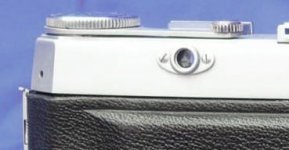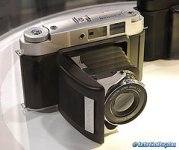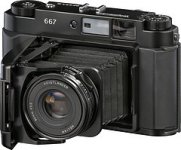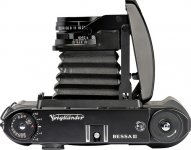I don't know why everybody is just focusing on this winding knob. Would a lever be that much quicker than a knob? And why the need for quick winding with a folding camera, which is obviously not designed for quick action shooting? As it has already been stated here, the mechanism associated with the lever would make the camera less reliable, much noisier (ratchet), more expensive and bulky. A protruding lever would also make the camera less pocketable, negating the main advantage of the folding camera concept.
Rubbish!
Answers:
1. Quicker and more convenient
2. Why would a lever mechanism be more unreliable than other mechanical part of the camera? You don't hear people complaining that they wish their 35mm cameras had rewind knobs like in the old days because they were so much more reliable! <rolls eyes>
Anyway, presumably it has a modern film-advance mechanism, since it uses 220 film, so 99% of the needed mechanism is already present.
3. My Certo Six has an advance lever but no noisy ratchet
4. Expense - again, I don't think so. The difference in design and manufacturing costs between a knob and lever mechanism would be negligible.
5. Bulky - once again, not necessarily - look at my Cero Six's lever, below. Hardly bulky!
I think the knob is a poor choice, and a case of nostalgic design over function. One reason I chose my Cero Six when looking for a compact 6x6 camera was because it had a convenient lever-operated film-advance mechanism.
The bellows I can understand - makes the camera more compact.
I'm not a fan of nostalgia. A tool should always be designed with function over form (by all means design it well - no need for ugliness!). To my eyes, the GF670 is more of a design exercise than a photographer's tool.
I'm a recent convert to 6x6, having cut my photographic teeth on modern digital cameras. Ideally, I would have liked a modern Mamiya 6 but couldn't afford it, plus it's still a bit bulky. So, I had to buy an old folding camera - choosing one was a nightmare as I had to wade through nostalgia and posts written by people wearing rose-tinted spectacles, resulting in me buying cameras that did not meet my expectations.
For example, I bought an Iskra. This is a total pile of **** as an efficient photographic tool. How can folk can wax lyrical such a crudely built camera!? See
http://www.rangefinderforum.com/forums/showthread.php?t=61709
Then I bought a Certo Six. It had some serious faults but now that I've attacked this "classic" with files, a hacksaw and my drill, it's much more user-friendly to use - if uglier! (I have a friend who keeps whining about how I've destroyed it - it's a tool not a piece of art!) See
http://www.rangefinderforum.com/forums/showthread.php?t=65609
Anyway, my point is, it seems that some manual modern cameras suffer from poor design by harking back to the past too much. The GF645 does too - I would be more interested if it took the best features of traditional medium-format folding cameras and married them to modern technology, and ignored retro styling. Perhaps I think this way because my first camera was Canon 10D digital SLR....
By the way, my main camera is the Leica M8, and this suffers from retro design too - it would be a far better camera if they'd followed the Epson R-D1 (my previous camera) design, with external controls for ISO, etc., and left nostalgia behind (that pointless, ridiculous base plate! <rolls eyes again>).





